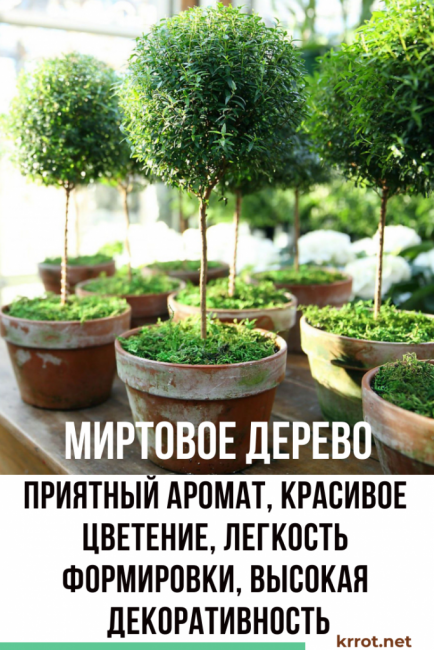
The myrtle tree, originally from the Mediterranean, fell into the ranks of indoor plants not by chance. It not only decorates the room, but gives it a special style, perfectly fitting into the interior of modern apartments.
Shearable, meets standard in the form of a sphere, cube, cone. It can be grown as a shrub or tree.
And bonsai from ordinary myrtle looks exotic. The leaves contain essential oils that purify the air.
Features of growing a myrtle tree - in our article.
Content:
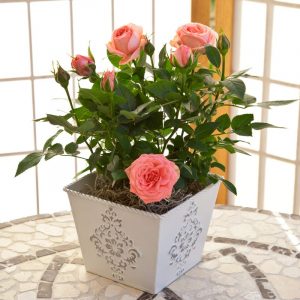 Read also: Rose home (room) in a pot: care after purchase, cultivation (20+ Photos & Videos) + Reviews
Read also: Rose home (room) in a pot: care after purchase, cultivation (20+ Photos & Videos) + Reviews
Description of the plant and its brief characteristics
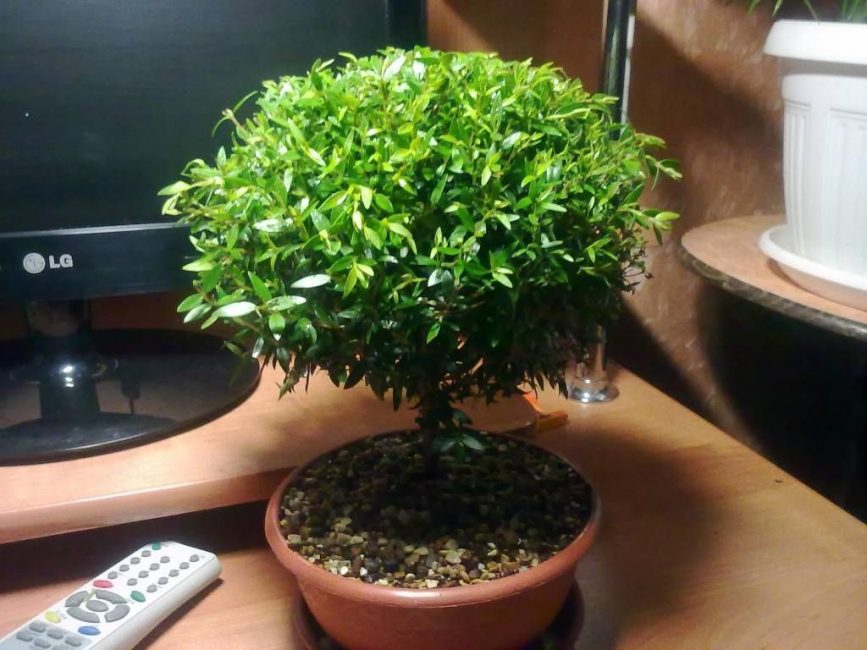
myrtle tree
The genus Myrtus belongs to the Myrtle family and includes about 100 small trees and evergreen shrubs that grow up to 3 m in natural conditions. They reach the same size in greenhouses and winter gardens, but indoor myrtle or common myrtle (Myrtus communis) is small and compact, its maximum size is a meter.
The myrtle tree is characterized by special features:
- life form - evergreen woody shrub;
- the stem is covered with red-brown, exfoliating bark;
- leaves are leathery and shiny, arranged oppositely on short petioles;
- their shape is oval or lanceolate;
- blooms in early summer;
- myrtle flowers up to 2 cm in diameter, white or pale pink, arranged singly;
- the stamens are longer than the petals, which makes the flowering tree look fluffy;
- starting to bloom, they emit a delicate aroma and the tree simply smells sweet;
- rounded fruits-berries the size of a pea are edible, up to 15 seeds ripen in them.
The plant belongs to spices and essential oil crops. It is cultivated in open ground in most countries of Western Europe, India, Ethiopia, Somalia. In Russia, it grows in the coastal zone of the Crimea and on the Black Sea coast of the Caucasus. Common myrtle has a small distribution area in our country due to low winter hardiness. The spicy plant is able to withstand short-term frosts down to -12C.
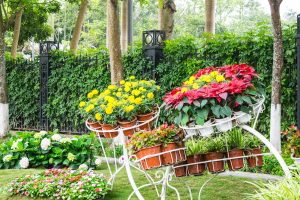 Read also: Perennial flowers (TOP 50 species): garden catalog for giving with photos and names | Video + Reviews
Read also: Perennial flowers (TOP 50 species): garden catalog for giving with photos and names | Video + Reviews Home Care
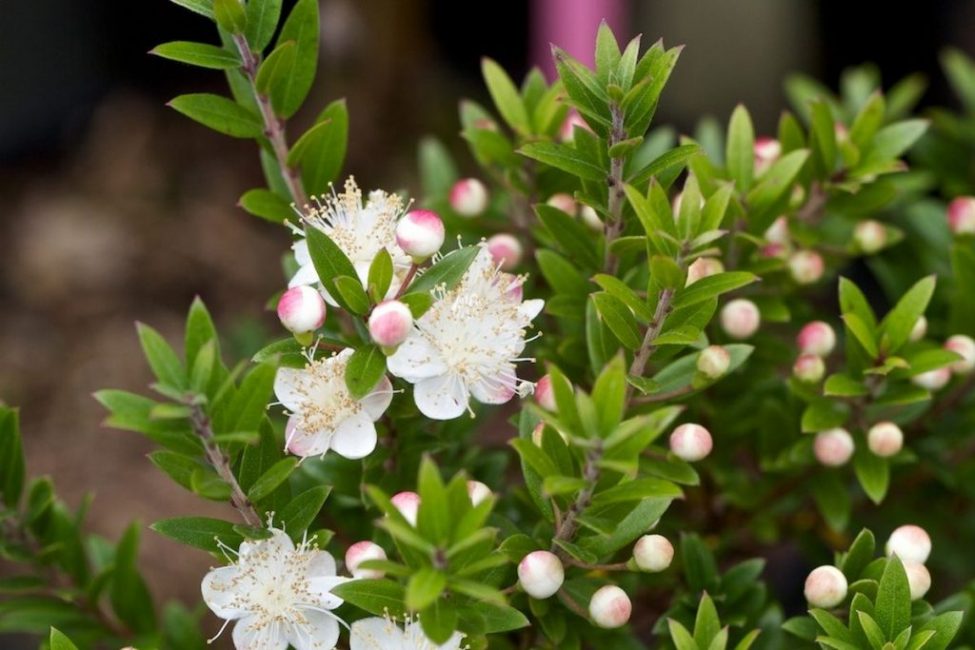
Delicate, fragrant blooms last all summer
Knowing how to care for myrtle, you can grow a healthy and fragrant tree. But not everyone can see the flowering.
A moody plant becomes like a flower bouquet under ideal growing conditions. Caring for Myrtus communis requires a certain approach and has its own subtleties and nuances.
illumination
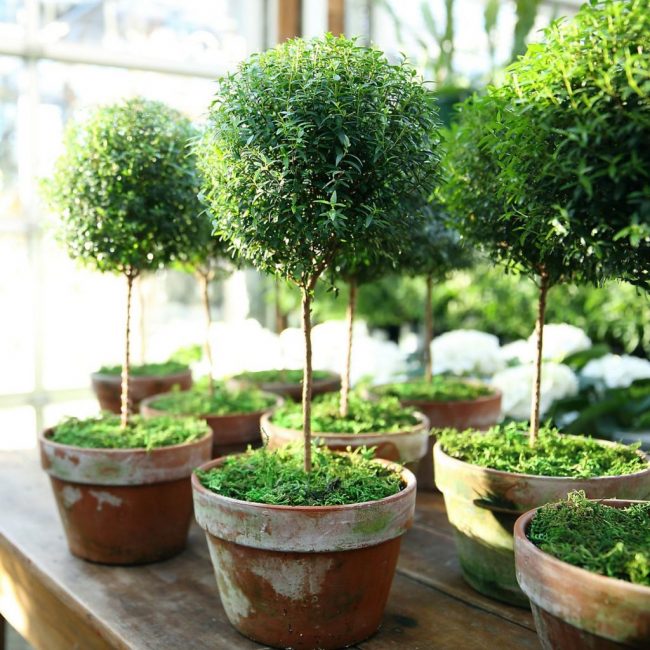
Myrtle tree - light-loving plant
At home, myrtle grows in diffused, bright light, but not in direct sunlight. This is a light-loving plant, for which western and eastern window sills are ideal. In the summer, the myrtle pot is moved to a bright area, if necessary, shade is created.
Spicy culture is extremely sensitive to light, so experienced flower growers transfer it to the corners of the apartment with optimal lighting. In winter, they move it to the south window, and in summer they keep the plant on a loggia or balcony, give it a "breathe of fresh air."
Temperature regime

The optimum air temperature in summer is +18-20°C
The Mediterranean climate has had its impact on the common myrtle, which has a genetically fixed love for moderate temperatures and coolness. Summer temperature range is +18-+20C. Midday heat is the enemy of the myrtle.
In winter, it is desirable to maintain no more than + 6- + 8C, so that in summer the plant will please with lush flowering.
A spicy tree needs a dormant period when it accumulates strength for subsequent growth and flowering. For wintering, myrtle is placed in a cool room for 3 months (for example, on a closed loggia). During this period, the spicy culture rarely needs watering, it is not fed or sprayed.
If you leave it warm, in standard apartment conditions, then the rest period will be reduced to 1.5 months. In heat and dryness, the myrtle sheds its leaves and does not bloom. With regular ventilation and drafts, the same troubles occur.
Watering and moisturizing
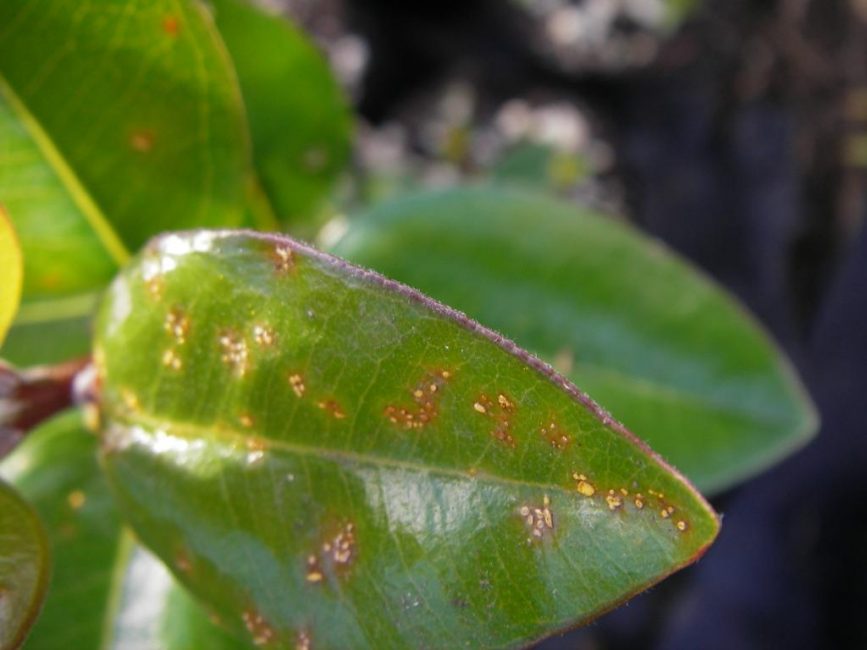
Drying leaves of house myrtle
Indoor myrtle is a moisture-loving plant. Abundant watering in spring and summer is a prerequisite for growth. It is impossible to allow the earthen coma to dry out: the tree is extremely negative about this, its leaves fall and the branches dry up.
When transfused, the roots rot. For irrigation use warm, settled water. In winter, their number is reduced.
Around Myrtus communis, you need to create a "wet cloud". For this it is recommended:
- periodic spraying;
- using a humidifier;
- placement on a pallet with wet pebbles or moss;
- washing the leaves in a warm shower.
The composition of the soil and top dressing

Horse peat - the basis of the soil mixture for the myrtle tree
For myrtle, the following composition of the earthen mixture is suitable:
- sod land - 1 part;
- humus - 1 part;
- peat and sand - 1 part each.
The same components include universal soil, which are purchased in garden centers. The plant prefers slightly acidic or neutral soil composition, which should be considered when planting.
In the spring-summer period, top dressing is carried out twice a week. Use purchased complex fertilizers for indoor plants. Spicy culture is watered with a solution diluted according to the instructions.
If you want to see flowering, then fertilize with complex compounds for flowering plants, which contain more potassium and phosphorus. If a bush without flowers is quite satisfied, then mixtures are used for decorative leafy forms, in which there is more nitrogen. In winter, during the dormant period, the plant is not fed.
Landing and transplant
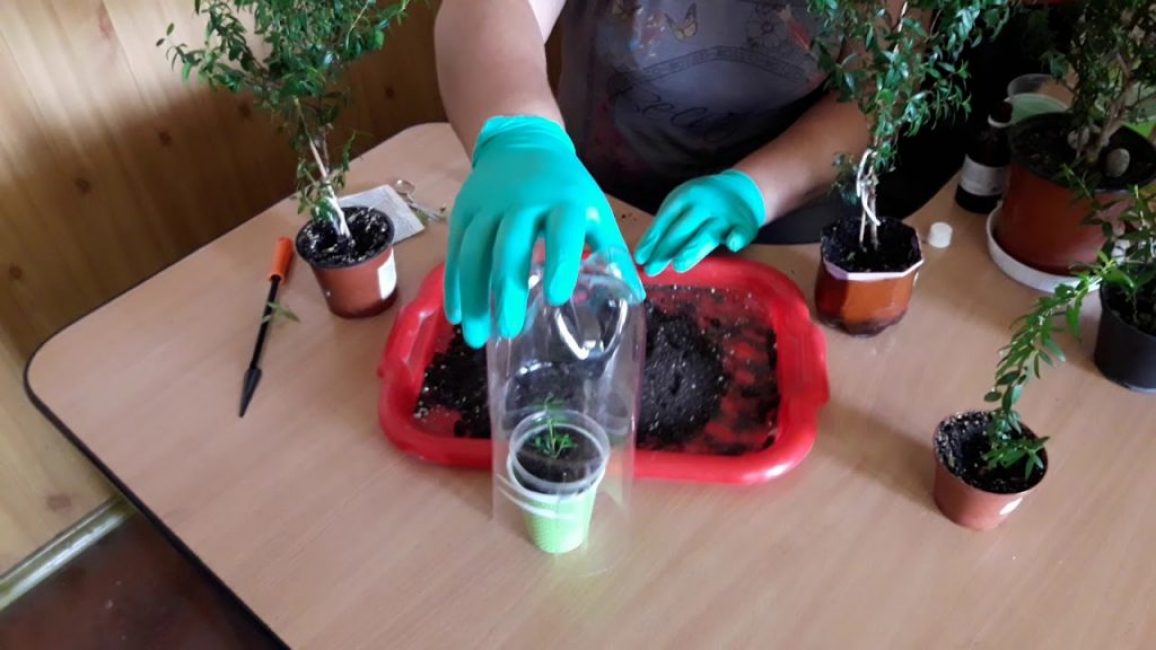
Young plants are transplanted annually, adults - once every 4-5 years.
Common myrtle can be bought at the garden center (the range of varieties is low). After a week of quarantine, transplant into another, larger pot. The container is selected for 5 years, after which another transshipment will be required. The plant develops slowly: growth per year is 0.2 m.
Be sure to have drainage holes and a drainage layer of pebbles or expanded clay, so that moisture does not stagnate during irrigation. The new "green pet" is transferred into a container along with an earthy clod without disturbing the root system. The voids are filled with fresh earth and watered. The plant is sprayed with "Epin" or "Zircon" (growth stimulants) to increase stress resistance. Shade for a while so that the bush takes root.
If the bush is small, then it is transplanted annually, increasing the diameter of the new pot by 2 cm. In an adult plant, the top layer of soil is removed and fresh is added.
Once every 4-5 years, the myrtle is transplanted into fresh soil. When planting, the roots are covered with earth to the root collar, which remains on the surface.
 Read also: Projects of country houses for 6-10 acres: 120 photos, description and requirements | The most interesting ideas
Read also: Projects of country houses for 6-10 acres: 120 photos, description and requirements | The most interesting ideas
Cropping Features
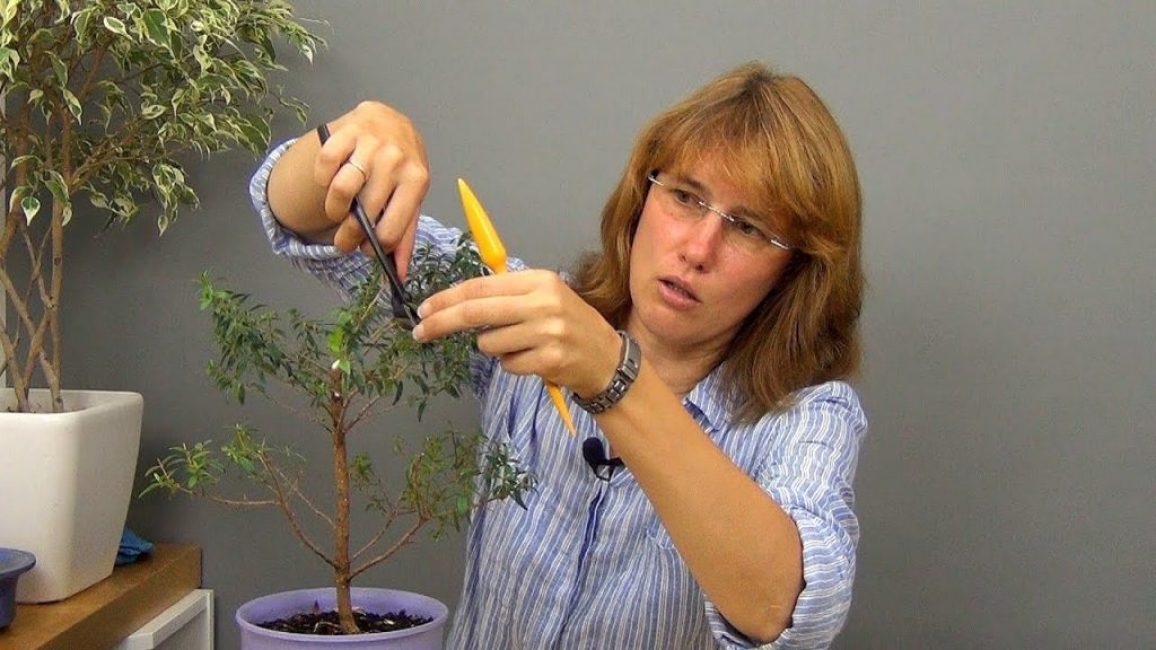
Myrtle tolerates pruning well, so it is given the desired shape
Common myrtle care includes pruning. It is not necessary to conduct it: the tree is able to grow on its own, and form a natural pyramidal crown.
But if you need to give the plant a certain shape, then you should work according to the rules:
- Pruning of semi-lignified shoots is carried out in early spring or after flowering.
- To create a tree, side shoots are shortened.
- To get a bush, twigs are cut from above.
- The bush is formed in the form of a cube, ball, pyramid
- You can shorten the stems and roots, pick up a special container and create a bonsai ("plant in miniature")
Frequent pinching and pruning give the plant a beautiful, unusual look (crown formation), but the chances of seeing a beautifully flowering myrtle are reduced to zero. The choice remains with the owner: if flowering is preferred, then pruning should be minimal or not carried out at all.
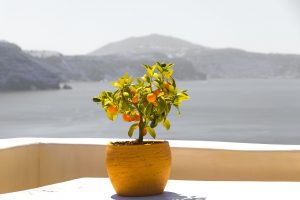 Read also: Orange: description, planting, growing at home, reproduction and care (Photo & Video) + Reviews
Read also: Orange: description, planting, growing at home, reproduction and care (Photo & Video) + Reviews Reproduction methods
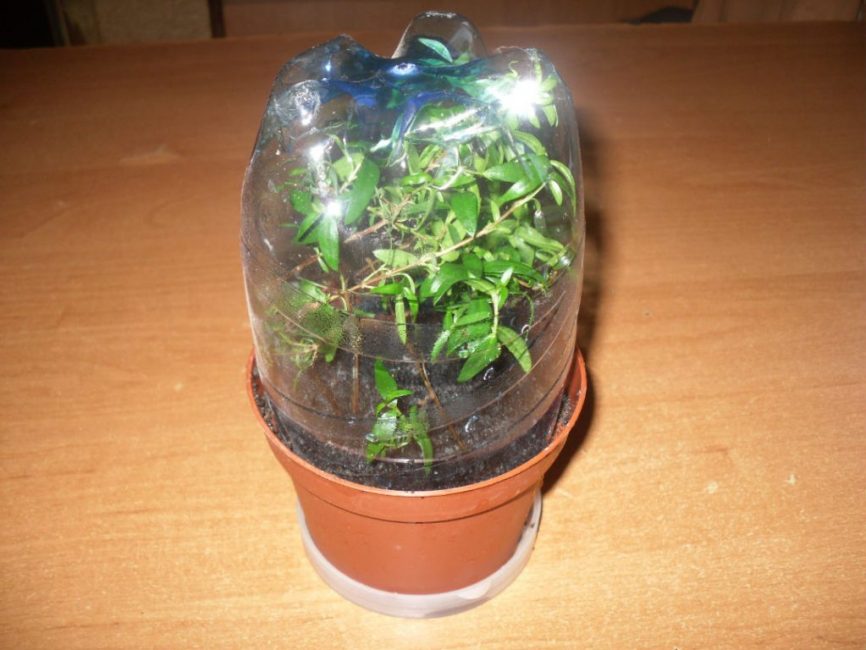
High humidity is created in the mini-greenhouse, which contributes to rooting
Myrtle is propagated by cuttings. This method is used in floriculture, because it is convenient and preserves the varietal characteristics of the plant. It is held in late spring or early summer.
The step by step process looks like this:
- In an adult specimen, a green annual green or woody cutting 12-15 cm long is cut off. Leaves are removed from its lower part, and leaves are cut off half from the upper part
- The base is treated with a root formation stimulator (Kornevin or Heteroauxin powder). The cut point on the bush is sprinkled with ash or charcoal powder to avoid microbes getting into the wound.
- Prepare a container with drainage holes in advance by pouring a mixture of sand and peat into it
- A cutting is placed in the substrate, deepening it by ¼ part
- They create a greenhouse effect, cover the container with a plastic container or bag. The sprout is constantly moistened, and the micro-greenhouse is ventilated
- Put in a warm and dark place. It is important to shade the cuttings, and then within a month the young shoots take root.
- They are planted in a mixture of hardwood, biohumus and perlite, using a pot with a diameter of 7 cm. A year later, the grown plant needs to be transplanted into another pot, 2 cm larger than the previous one.
- They pinch the top, then lateral shoots appear in the axils of the leaves and the bush becomes sprawling
By the way, roots will also appear if the shoot is simply put in water, which should be changed periodically. The root system develops within a month and a half. Myrtle, grown from cuttings, blooms in 2-3 years.
Information about the care, transplantation, cuttings of myrtle is presented in the video:
MIRT: transplantation, cuttings, care
Common Myrtle Flower: Planting, Growing and Care at Home (25+ Photos & Videos) + Reviews
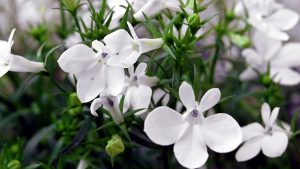 Read also: Lobelia: description, planting and care, when it should be sown, description of varieties (50 Photos & Videos) + Reviews
Read also: Lobelia: description, planting and care, when it should be sown, description of varieties (50 Photos & Videos) + Reviews
What the plant is sick with: problems of survival
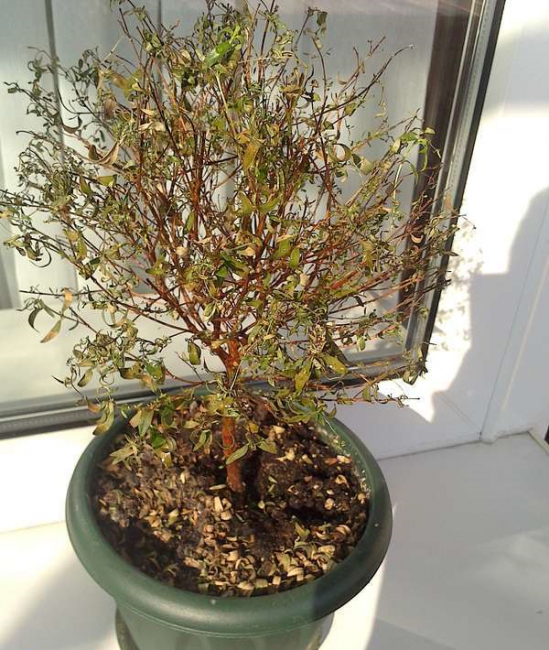
The photo of myrtle shows that the plant does not feel the best way
Myrtle home will grow up healthy if you follow all the rules for care. But from time to time, the Mediterranean plant has problems:
- Pest attack. The plant is affected by thrips, aphids, mealybugs, scale insects, and spider mites. Against this "scourge" there are a lot of infusions based on natural remedies. In extreme cases, apply insecticides or acaricides (against ticks), observing the necessary safety measures.
- Foliage blackening. Associated with excessive watering and stagnant water. It is necessary to reduce the frequency of irrigation, loosen the soil or replace it with fresh
- Yellowing of leaves. Indicates a lack of moisture. Increasing watering and foliar spraying will solve the problem.
- The leaves curl up and fall off. The problem occurs in winter due to excessively dry air. In the spring, the tree will gradually recover
- The leaves become sticky. This is a sign that a soot fungus has appeared on it from scale pests. The plant is treated with a suitable insecticide
- The stems are stretched, the foliage turns pale. A clear sign of lack of light. Home myrtle is transferred to a western window or a place with diffused, bright light is selected.
- The bush dries up. This indicates an overdrying of the earthy coma and a dry microclimate in the room. It is necessary to increase the frequency of watering, spray the plant, put a tray with wet moss or pebbles under the pot
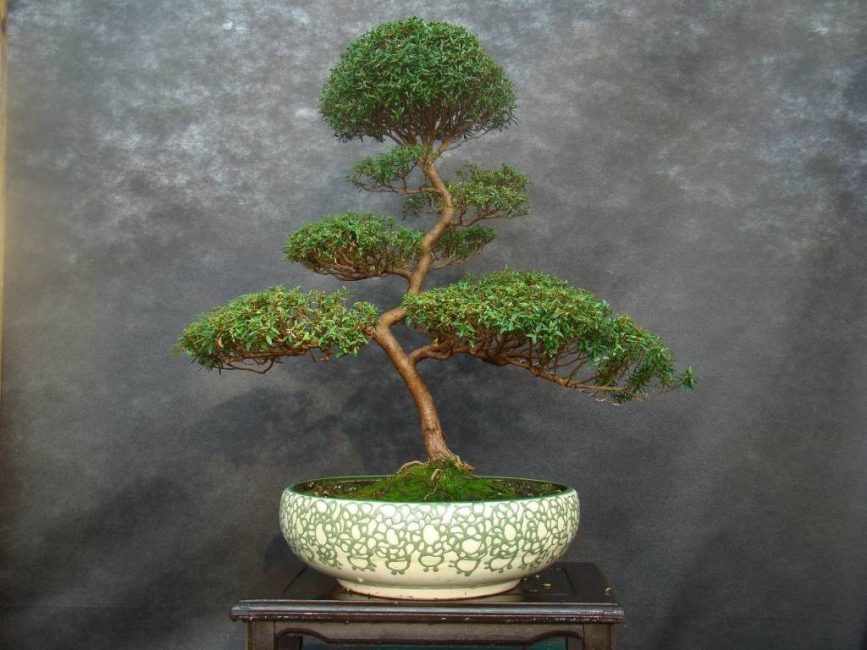
Making bonsai from myrtle is a special approach, creativity and art
Most often, flower growers are faced with the problem of shedding foliage. There are plenty of reasons for such “behavior” in common myrtle:
- too high temperature;
- poor water quality;
- drafts;
- lack of light;
- rare watering;
- frequent watering.
You need to approach the problem individually and check which rules of care are violated. If the myrtle has shed its leaves, then the shoots are cut to half, the plant is placed in diffused light, carefully (once every 2-3 days) watered, sprayed. With a comfortable content, the bush will “dress” in new foliage in 2 weeks.
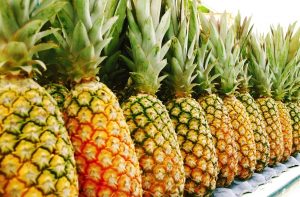 Read also: Pineapple: description, planting and growing at home, dessert recipes (Photo & Video) + Reviews
Read also: Pineapple: description, planting and growing at home, dessert recipes (Photo & Video) + Reviews Common myrtle varieties
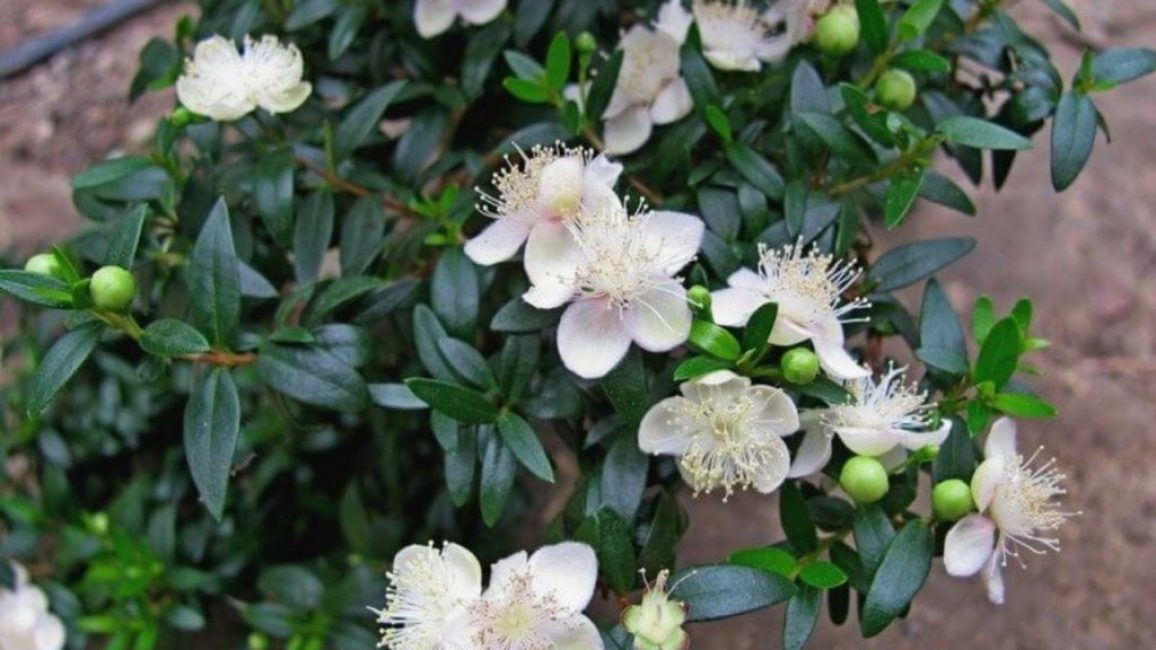
On the basis of ordinary myrtle, a number of indoor varieties have been created
In pot culture, one species is grown - ordinary myrtle. On its basis, varieties have been created that differ in size, shape and color of the leaf blade, density of the bush, color of berries-fruits, color of flowers, and their shape.
The most famous varieties:
- Alhambra (Alhambra) - bush dense, thick, with white fruits;
- Flore Pleno (Flore Pleno) - interesting double flowers;
- Variegata (Variegata) - variegated leaves enhance decorativeness;
- La Clape - grows quickly and forms large, dark blue berries;
- La Clape Blanc - similar to the previous variety with white berries-fruits;
- Leucocarpa - not much different from traditional varieties;
- Mycrophylla - dwarf small-leaved form;
- Tarentina (Tarentina) - dense, dense bush covered with small foliage, characterized by abundant flowering;
- Tarentina Granada (Tarentina Granada) - standard, with white berries;
- Tarentina Variegata (Tarentina Variegata) - characterized by variegated foliage.
An interesting variety of myrtle called Boetica. The bush grows slowly, forms large, up to 6-7 cm in length, elongated, pointed leaves. The cinnamon-colored trunk is able to twist, forming unusual shapes. It blooms with white flowers, the berries are black, slightly oblong.

lemon myrtle
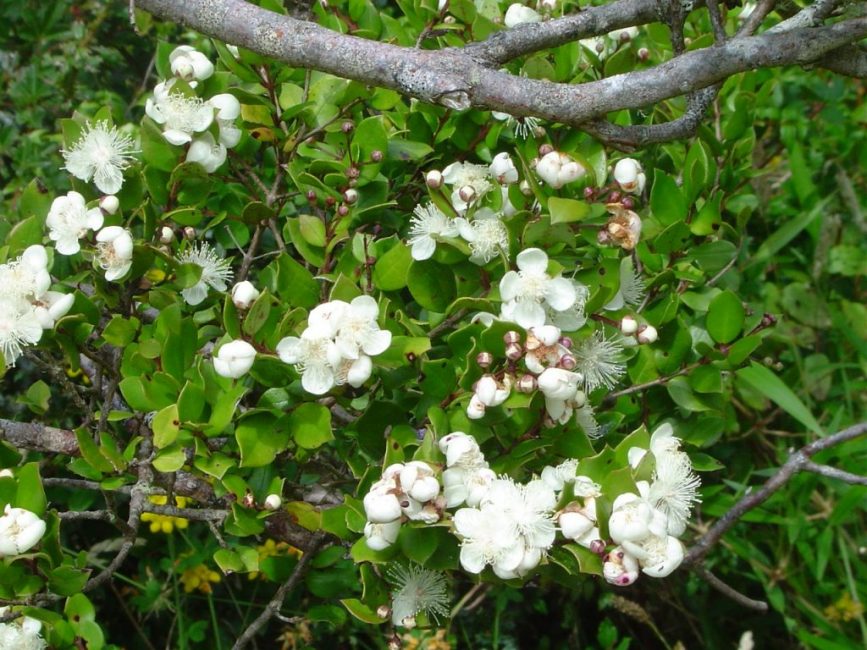
Chilean myrtle (luma apiculata)
 Read also: Cyclamen - bulb violet: description, growing from seeds at home, plant care, reproduction and transplantation (75+ Photos & Videos) + Reviews
Read also: Cyclamen - bulb violet: description, growing from seeds at home, plant care, reproduction and transplantation (75+ Photos & Videos) + Reviews Mysterious myrtle: history, myths and legends

Unpretentious wreath of myrtle according to legend gives amazing beauty
The first mention of myrtle ordinary dates back to 1499. It was found in the Gennadiev Bible. But historical data on the plant is rather scarce. But it is shrouded in many myths and legends.
One of the legends says that Aphrodite, the goddess of love and beauty, often wore a myrtle wreath. It was thanks to the unusual decoration that Paris recognized her as the most beautiful on Earth. Since that time, myrtle began to be considered the sacred tree of Aphrodite. The Greeks today put a sprig of myrtle under the pillow of every newborn girl so that she grows up as beautiful as Aphrodite.
The tradition of giving a myrtle tree for a wedding has come down to our times. This is a symbol of well-being and happiness of a young family. Later, a myrtle stalk from the wedding plant is planted in the yard as the hope for a long, devoted love.
A love amulet is created from a sprig of a myrtle tree. The dried flower shoot is placed in a canvas bag and worn on the chest under clothing.
It is believed that such a talisman will give happiness and love to lonely people. He will also protect a woman from encroachments on her honor. And if you wear a talisman to spouses, then this will save them from betrayal and jealousy.
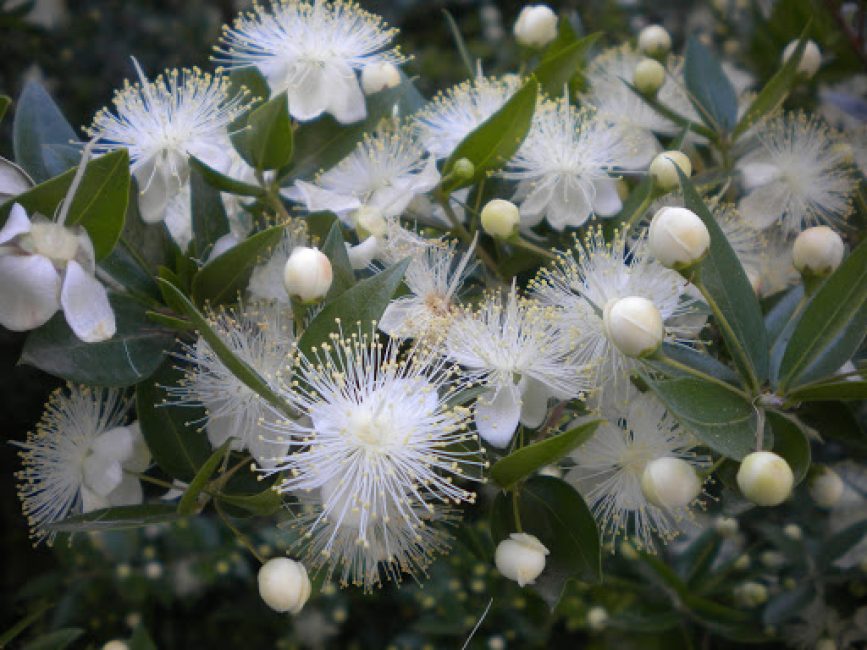
myrtle bloom
Various signs are associated with ordinary myrtle:
- The tree is placed in the house near the entrance. This protects the home from negative energy. If an ill-wisher appears, then the plant absorbs the energy emanating from it, which can cause harm.
- Myrtle is planted only by the mistress of the house. At the same time, she should be in beautiful clothes and think only about good and kind. Mentally thank the tree for the fact that it will grow in the house, give prosperity, love, well-being
- The flowering of room culture is equated with the purity and purity of the bride. If the bush has blossomed, then love and prosperity will settle in the house, and its wilting threatens trouble. That is why the plant is looked after especially carefully.
In any case, the growth of myrtle in the apartment - this is a good sign that gives hope for the warmth and well-being of the family hearth.
 Read also: Hibiscus (Chinese rose): description, cultivation, reproduction and care, possible diseases of tropical mallow | (75+ Photos & Videos) + Reviews
Read also: Hibiscus (Chinese rose): description, cultivation, reproduction and care, possible diseases of tropical mallow | (75+ Photos & Videos) + Reviews Healing properties of the Mediterranean plant

Essential oil based on myrtle is used in cosmetology, medicine, aromatherapy
Homemade myrtle leaves are rich in healing essential oils. They contain special substances - phytoncides, which are detrimental to any pathogenic microflora, pathogenic bacteria. This is a home ecologist who saves from influenza, acute respiratory infections, acute respiratory viral infections, giving a person vigor and additional strength.
He is usefully kept in the room of a sick person. By the way, he will be in the kitchen. Moreover, its leaves are used in cooking.
It is used to treat:
- acne;
- relieve spasms in bronchitis;
- wounds as a wound healing agent.
In terms of its medicinal properties and the composition of essential oils, it is close to clove and eucalyptus. They also have a bactericidal effect and increase immunity.
The fruits and leaves are used to make liqueurs. Flowers and leaves are "in service" with cosmetologists. Dried leaves are added to tea as a spice.
In the church, during worship, they use it as incense, to create a special atmosphere of grace.
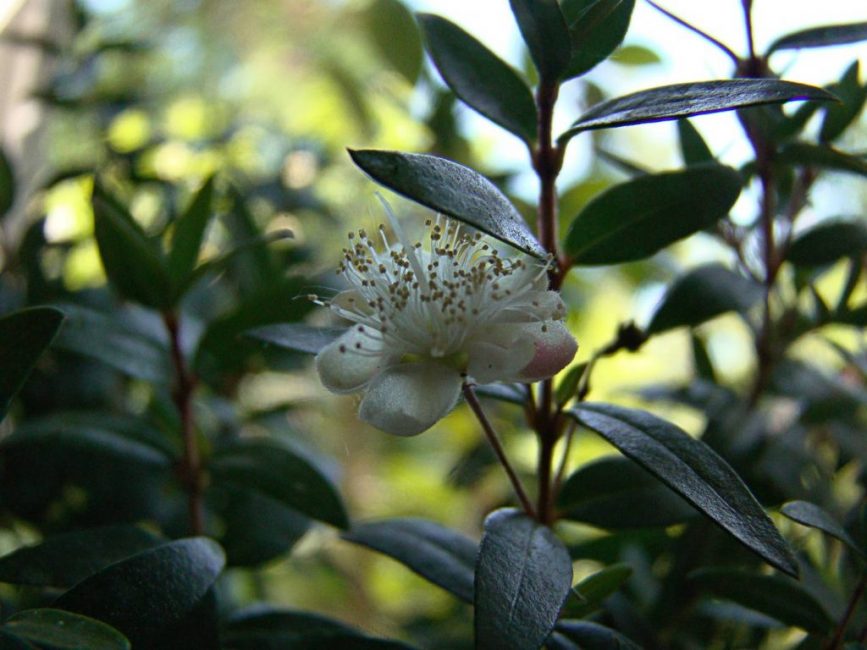
Myrtle ordinary
Myrtle ordinary is not just decorative, it creates a special microclimate in the room. It is believed that the aroma of oils improves human performance, so the plant is often found in offices at workplaces. Common myrtle undoubtedly deserves attention and a special place in the home collection of indoor plants.







The gift presented to me, myrtle in a pot, turned out to be a failure. And I know that he was purchased at the garden center. However, the girl who gave it did not voice special care rules, explaining that the plant is unpretentious, despite its foreign origin) Type, it needs watering with settled water, but not to be thrown in the heat, as with “ordinary” greens. Well, of course, everything happened suddenly. A month was enough for the bush to begin to dry, wither and bend, despite various attempts to save the new pet. Only later, when I, grieving, shared an unsuccessful outcome, a biologist friend explained that most of these pots from nurseries are grown by distillation. And what is the main thing? That's right - quantity and accelerated growth, the more you sell, the more you get. So they pump up the rastyushki at the very “I don’t want” top dressing, but at home you cannot recreate such greenhouse conditions by any miracle, as a result, for many, not only me, “lucky”, the pot with beauty dies, alas. I will take from friends, from the home collection.
Thanks your article was helpful for me!